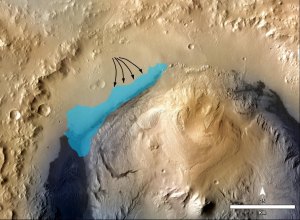
Possible extent of an ancient lake inside Gale Crater. -- NASA illustration.
The lake is in the same area being explored by the Mars rover Curiosity, The New York Times reports. It contained water for hundreds of thousands of years and maybe longer. Scientists aren’t certain yet whether it also contained life, but data sent to Earth from Curiosity indicates that past life on Mars is at least a possibility.
“The environment would have existed long enough that they [microbes] could have been sustained, prospered, grown, multiplied,” said John P. Grotzinger, a professor of geology at the California Institute of Technology, the project scientist for the Curiosity mission. “All the essential ingredients for life were present.”
Scientists think the lake, which existed some 3.5 billion years ago, was about the size and shape of one of the Finger Lakes near Lake Ontario in New York, according to The Washington Post. The water may have come and gone or been iced over at times. It was part of a habitable environment that included rivers and groundwater.
"In a little more than a year on the Red Planet, the mobile Mars Science Laboratory has determined the age of a Martian rock, found evidence the planet could have sustained microbial life, taken the first readings of radiation on the surface, and shown how natural erosion could reveal the building blocks of life,” according to NASA.
Additional results from Curiosity provide the first readings of radiation hazards at Mars' surface, which will aid in the planning of human missions to Mars. Other findings will guide the search for evidence of life on Mars by improving insight about how erosion may expose buried clues of molecular building blocks of life, the agency says.
Curiosity team members presented these results and more in six papers published online Monday. by Science Express and in talks at the Fall Meeting of the American Geophysical Union in San Francisco.